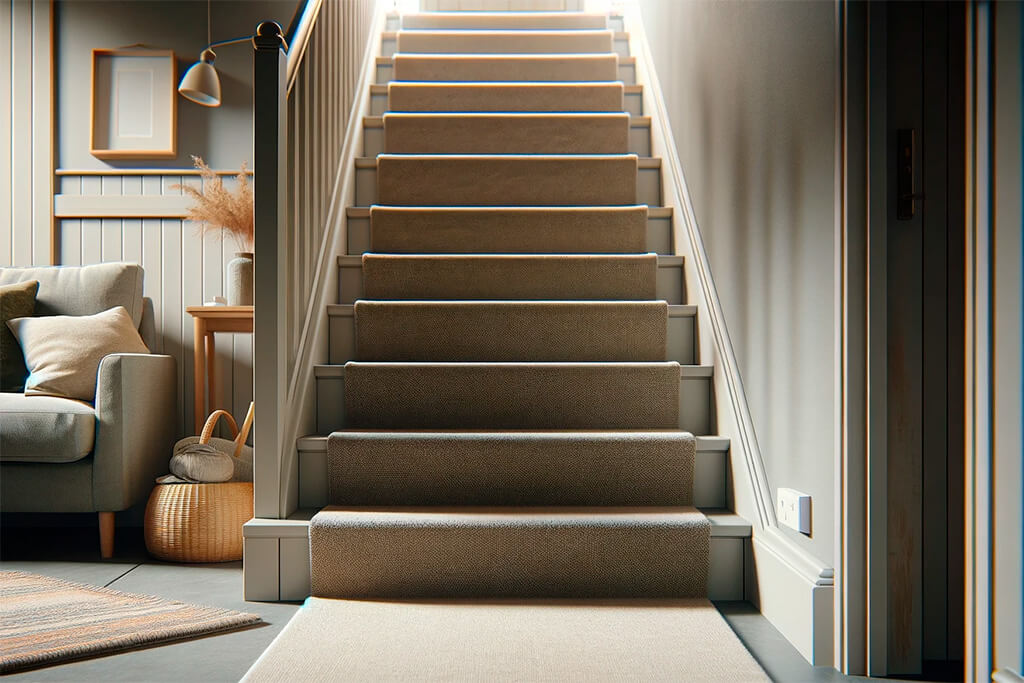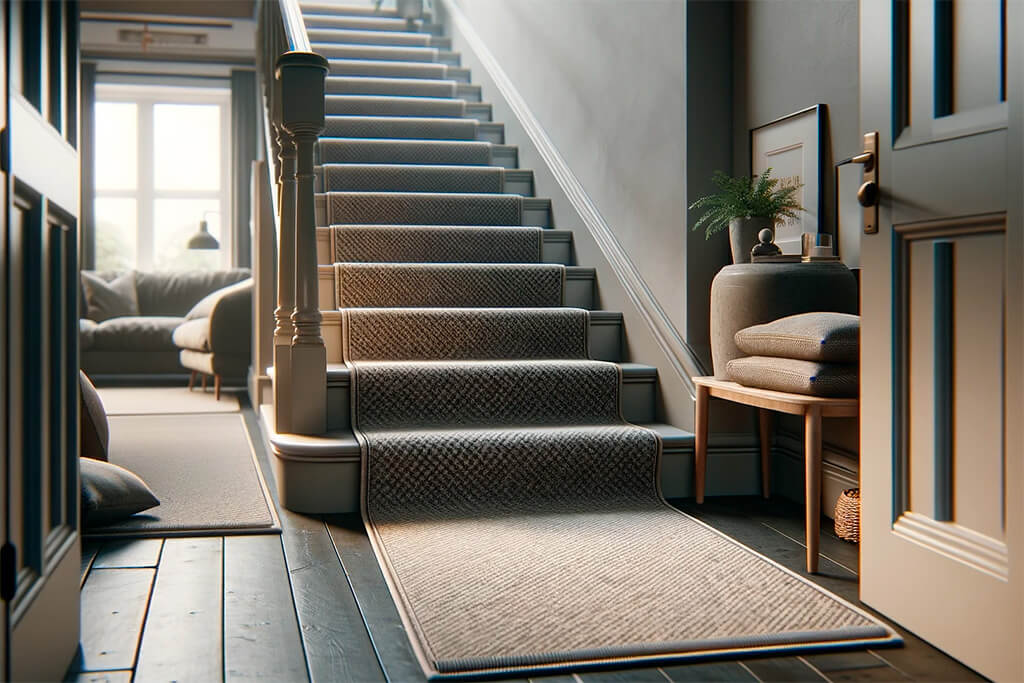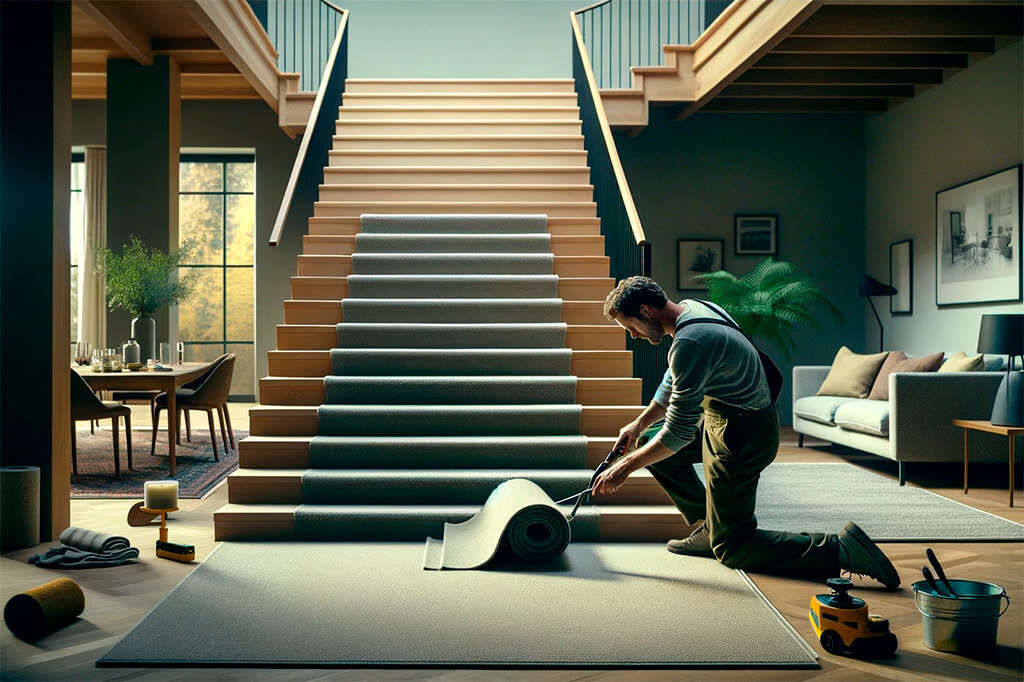Embarking on the task of installing a stair runner is a practical way to elevate the aesthetic and safety of your home. This guide is crafted for DIY enthusiasts, home handymen, and small-scale professional builders who are keen to tackle this project with precision and finesse.

Why Install a Stair Runner?
A stair runner is more than a decorative element, it’s a functional addition to your home. Aesthetically, it can transform a mundane staircase into an elegant, eye-catching feature. On the practical side, stair runners contribute significantly to safety by providing a non-slip surface, an essential aspect in any home. They also play a role in noise reduction, softening the sound of foot traffic, and adding a degree of comfort underfoot that hard steps simply can’t offer.
Tools and Materials Needed
To ensure a successful installation, you’ll need the right set of tools and materials:
- Measuring Tape: Precision in measurement is key to a well-fitted runner.
- Staple Gun: For securing the runner firmly in place.
- Utility Knife: A sharp knife is essential for clean cuts.
- Straight Edge or Square: Ensures straight lines and accurate cuts.
- Hammer and Nail Set: For the traditional approach of securing tack strips.
- Knee Kicker: Optional, for stretching the carpet if necessary.
Materials will vary based on your choice of runner. Wool and synthetic blends are common options, each with unique characteristics. Remember to include tack strips for anchoring the runner, padding for comfort and longevity, and possibly adhesive depending on your staircase material.

Preparation Steps
- Measuring Your Stairs: Accurate measurement is the foundation of a successful installation. Measure the width of the stairs, the depth of each tread, and the height of each riser. Allow extra inches for adjustments and trimming.
- Choosing Your Runner: Select a runner that complements both the design of your home and your lifestyle needs. Consider durability if your staircase experiences high traffic.
- Prepping the Surface: A clean, smooth surface is crucial. Remove any debris, old nails, or staples from the stairs. This ensures a clean canvas for your installation, eliminating potential issues that can arise from an uneven surface.
Approach each step methodically, and you’ll set the stage for a stair runner installation that is not only visually appealing but also structurally sound and enduring.
Step-by-Step Installation Guide
1. Centering the Runner
Properly centering your runner is the first crucial step. This isn’t a place for guesswork, a measuring tape is your best friend here. Measure the width of your staircase and then your runner to ensure that equal spaces are left on both sides. This symmetry is key for both aesthetics and safety.
2. Attaching the Tack Strips
Tack strips, those small but mighty elements, need careful placement. Set them about half an inch from the rear edge of each tread, aligning them with precision. Secure them with a few firm hammer strikes on the nails. This will ensure a firm grip for your runner.
3. Laying the Padding
Padding isn’t just for comfort, it extends the life of your runner. Cut the padding to match each step’s size, leaving a small gap around the edges to avoid bulkiness. Staple it firmly in place, ensuring it’s flush with the tack strips. This step requires attention to detail for a smooth, comfortable underfoot feel.
4. Installing the Runner
Starting at the top of the stairs, align your runner with the stair center and the tack strips. Attach it to the strips, ensuring it grips the pins securely. A knee kicker can be employed here to stretch the runner for a snug fit. Staple under the nosing for added security, taking care to keep the runner evenly tensioned.
5. Securing the Runner
Work your way down, keeping the runner taut and secure. Staple at the rear of each tread and the bottom of each riser, maintaining consistent tension. A well-secured runner reduces wear and presents a polished, professional appearance.
6. Finishing Touches
Trim any excess material at the end of the installation. This step requires a steady hand and a sharp utility knife for a clean, precise cut. Conduct a thorough inspection, ensuring the runner is secure and even along the entire length of the staircase.

Customization Tips
Tailor your installation to the specific character of your staircase. The width of the runner, the visibility of the stair material on either side, and the pattern of the runner itself can all be adjusted to suit the style of your home. This is where you can infuse your personality and taste into the project.
Maintenance and Upkeep
Regular maintenance, including vacuuming and immediate spot cleaning, will keep your runner in top condition. Be mindful of signs of wear, as stair runners do endure a lot of traffic. Replacement or repair might be necessary over time, and fortunately, with the skills you’ve now mastered, this will be a straightforward task.
Common Mistakes to Avoid
In the world of stair runner installation, precision and attention to detail are paramount. Drawing from years of experience, here are key pitfalls to avoid:
- The Pitfall of Inaccurate Measurement: Never underestimate the importance of precision. An error in measurement can lead to a host of problems, from aesthetic imbalance to functional deficiencies. Use a reliable measuring tape and double-check your figures.
- Ignoring Pattern Alignment: If your runner has a pattern, aligning it correctly is not just a detail, it’s essential. Misaligned patterns disrupt the visual flow and can diminish the overall impact of your work. Take the time to align patterns at each step and turn.
- Neglecting Secure Attachment: An inadequately secured runner is more than an eyesore, it’s a hazard. Ensure that each part of the runner is firmly affixed to the stairs, using appropriate tools and materials. A runner that shifts or bulges can lead to falls and injuries.

FAQ Section
How much material do I need for a staircase runner installation?
Accurately calculating the required material is crucial. Measure the width and depth of each step, then calculate the total length needed by multiplying the depth of one step by the number of steps, adding in a little extra for the risers and potential adjustments. It’s always better to have a bit extra than to be short.
Can stair runners be installed on all types of staircases?
Yes, stair runners can be adapted to most types of staircases. Whether your stairs are wood, tile, or another material, the principles remain the same. However, the complexity increases with the uniqueness of the staircase design, such as with spiral or excessively curved stairs.
How long does it typically take to install a stair runner?
For someone with experience, a straight staircase can take a few hours to complete. For beginners, allocate a full day to ensure you don’t rush and compromise quality. Complex staircases may require additional time and patience.
What’s the best way to ensure the runner is centered on the stairs?
Achieving perfect centering is about meticulous measurement. Measure the total width of the stair and subtract the width of the runner. Divide the remaining width by two to find the space required on each side of the runner. Marking these measurements with a chalk line can guide you during installation.
Is it necessary to use padding under a stair runner?
Padding is recommended for several reasons: it provides comfort, reduces noise, and prolongs the life of the runner. In some instances, like outdoor stairs, padding may be omitted, but for interior stairs, it’s a worthwhile investment.
Accurately calculating the required material is crucial. Measure the width and depth of each step, then calculate the total length needed by multiplying the depth of one step by the number of steps, adding in a little extra for the risers and potential adjustments. It’s always better to have a bit extra than to be short.
Yes, stair runners can be adapted to most types of staircases. Whether your stairs are wood, tile, or another material, the principles remain the same. However, the complexity increases with the uniqueness of the staircase design, such as with spiral or excessively curved stairs.
For someone with experience, a straight staircase can take a few hours to complete. For beginners, allocate a full day to ensure you don’t rush and compromise quality. Complex staircases may require additional time and patience.
Achieving perfect centering is about meticulous measurement. Measure the total width of the stair and subtract the width of the runner. Divide the remaining width by two to find the space required on each side of the runner. Marking these measurements with a chalk line can guide you during installation.
Padding is recommended for several reasons: it provides comfort, reduces noise, and prolongs the life of the runner. In some instances, like outdoor stairs, padding may be omitted, but for interior stairs, it’s a worthwhile investment.
